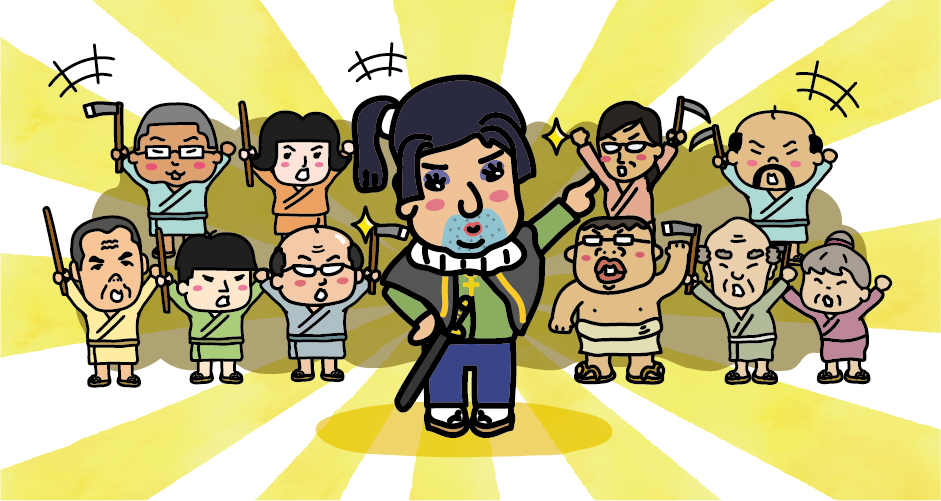“Dejima” in Nagasaki Prefecture
Nagasaki’s Dejima, which is in textbooks of history is now filled its surroundings and connected by the land.
“Dejima” in Nagasaki Prefecture is an artificial island created in 1636 for the policy of seclusion during the Edo period. The shape of an artificial island is a fan and the total area is about 1500㎡. This is about one-third the size of Tokyo Dome. The construction period was about 2 years and the total construction cost was about 400 million yen in terms of the monetary value as of today. The Edo Shogunate ordered merchants in Nagasaki to create this artificial land. There is an anecdote that when people asked about the shape of the island to the third Shogun, Iemitsu Tokunaga, he showed his fan.

Since 1549, when the missionary Xavier visited Japan from Spain, Christianity has been spread to Japan centering from Western Japan. Because missionary activities and trading came together, “Christian Daimyo” who went over to Christianity also appeared. Christian Daimyo made great profits in the trading which missionaries brought.

The main purpose of the policy of seclusion was the ban on Christianity. Because the political system of the Shogunate may be denied by the new thought of Christianity and the wariness of great profits that Christian Daimyo made from trading, the Edo Shogunate banned the visits of Spanish and Portuguese ships and tried to make a monopoly of trade (trade control).
At that time, the Dutch ships also visited Japan, but they did not work for the missionary but only trade. Rather than that, the Dutch told to the Shogunate that the background of missionary work of Spain and Portugal is a plan to invade Japan. As a result, the Shogunate banned the visit of Spanish ships in 1624.

The Portuguese ships were not banned because they handled raw silk that was indispensable to Japan. The Shogunate made Portuguese people live “Dejima” and continued trading while managing the access of people to the island. Merchants in Nagasaki were paid over 100 million yen for using that land from Portuguese merchants.

However, when a riot of Christian farmers occurred in Shimabara and Amakusa in Nagasaki, the relationship between the Edo Shogunate and Portugal got worse. In 1639, the visit of Portuguese ships was banned and Portuguese were expelled from the country.

After the Portuguese left, a Dutch trading house in Hirado, Nagasaki was moved to Dejima in 1641 to recover the construction cost of the artificial island. From 1639, when the visit of Portuguese ships was banned, the Netherlands had a huge monopoly on trade with Japan and gained great profits for 220 years until 1859, when the five major ports of Hakodate, Yokohama, Niigata, Kobe, and Nagasaki were opened to foreign countries.

Since today’s Dejima has been filled with its surroundings, there is no impression of fan-shaped island of that time. However, based on the picture of Dejima around 1820 painted by the Siebold’s personal painter, the one-fifteenth model of Dejima has been exhibited.

In 2017, as the Edo period, a bridge was built between Dejima and Edo Town on the opposite side for the first time in 130 years. At the beginning of the 19thcentury, Dejima had 49 buildings including houses, restaurants, warehouses, and guardhouses. Now 16 of them have been restored. It is very interesting to see the cityscape at that time is reproduced there.
By 2050, Nagasaki City aims to fully restore Dejima when it was surrounded by the sea.
Access to Dejima
It takes about 1 hour and 50 minutes from Haneda Airport to Nagasaki Airport.
It takes about 1 hour and 20 minutes from Itami Airport to Nagasaki Airport.
It takes about 45 minutes from Nagasaki Airport to JR Nagasaki Station by airport limousine bus. About 5 minutes by tram from Nagasaki Electric Railway Nagasaki Eki-mae to Nagasaki Electric Railway Dejima. Get off at the Nagasaki Electric Railway Dejima and walk for about 5 minutes.
It takes about 1 hour from JR Hakata Station to JR Takeo Onsen Station by JR Kagoshima Main Line (limited express). At JR Takeo Onsen Station, transfer to the Nishikyushu Shinkansen and get to JR Nagasaki Station in about 30 minutes.










You need to login to comment on an article.